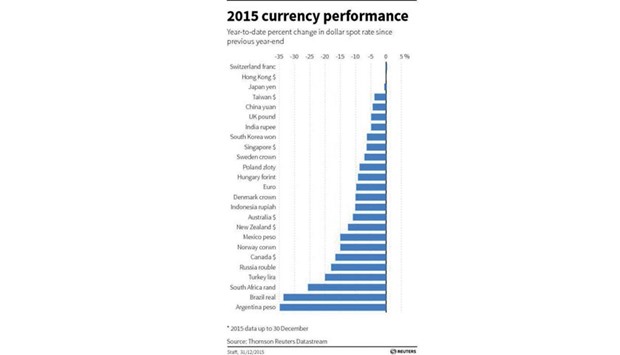China’s yuan weakened against the dollar yesterday, finishing the year with a record yearly loss of 4.7% after volatile trading in last five months.
A big question in global currency trade for 2016 is how much further the yuan might depreciate. Still, the Chinese currency has posted comparatively smaller losses against the dollar than other global currencies.
“We believe yuan depreciation is likely to continue through 2016,” said Craig Chan, FX strategist at Nomura.
Some traders forecast that it could slip as far as 6.80 to the dollar at the end of 2016, based on the slowing growth of the world’s second-largest economy and divergence in the value of the yuan onshore and offshore.
“We think China and the US will continue their (different) tone in monetary policy in 2016, which would boost the dollar and exert downward pressure on the yuan,” said a dealer at an Asian bank in Shanghai.
Prior to yesterday’s market opening, the People’s Bank of China (PBOC) set the midpoint rate at 6.4936 per dollar, its weakest level since May 2011 and 0.1% weaker than the previous fix of 6.4895.
The spot market closed at 6.4936 per dollar, 0.05% weaker than the previous close.
“The yuan moved barely today,” said a dealer at a foreign bank in Shanghai. “But it is still a volatile year.”
The Chinese currency shed 1.5% just for December, and saw its biggest yearly loss since 1994, when China established its foreign exchange market.
The International Monetary Fund (IMF) announced on Nov 30 that it decided to admit the yuan into its Special Drawing Rights (SDR) basket, an important milestone for the Chinese currency’s integration into global finances.
After the announcement, the onshore yuan lost 1.35% against the dollar in a 10-day consecutive depreciation, the longest weakening streak on record. The PBOC permitted the yuan’s fall, making its currency to be more market-oriented and internationalised.
Intervention by state-owned banks on behalf of the PBOC has eased since October, traders said, in contrast to August and September.
The PBOC abruptly devalued its yuan midpoint guidance rate on Aug. 11 by nearly 2%, which it called a reform of basing the midpoint on the previous day’s closing price.
But the subsequent expectations of steep depreciation forced the central bank to take unprecedented steps to support the yuan, along with rescuing measures to stabilise its stock markets, partly hit by the yuan’s weakness.
From January to July, before the landmark devaluation, the yuan had stayed around 6.2 per dollar.
China has cut its interest rates for six times since November 2014 in its latest easing cycle to boost its economic growth, while the US Federal Reserve hiked its interest rates for the first time since 2006 in December, narrowing the interest spreads of the two nations in favour of the greenback.
On Thursday, the offshore yuan was trading 1.18% weaker than the onshore spot at 6.5710 per dollar. It struck 6.6100 on Wednesday, its weakest level since September 2011, and is set for a 6% loss through 2015.
“Beijing is trying to converge the yuan’s offshore value with the onshore market,” said a trader at a foreign bank in Shanghai. “I think the onshore yuan will go down and close up to the offshore market in 2016.”
In further reforms, China’s onshore yuan’s trading hours in 2016 will last until 11:30pm local time (1530 GMT), rather than end at 4:30pm, a major reform step that should help onshore and offshore rates converge.

2015rn


